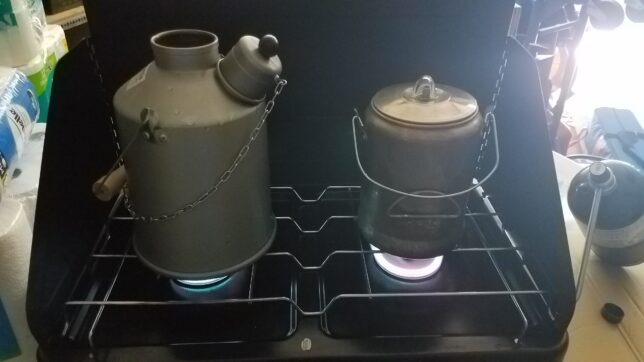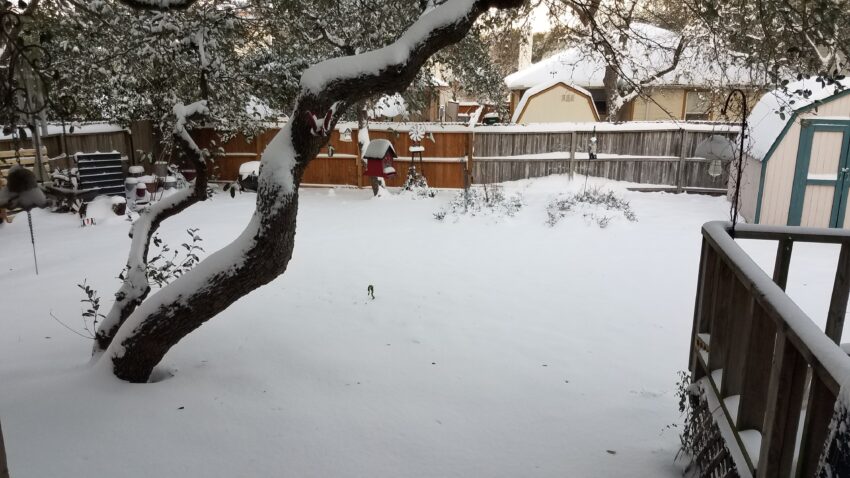As I write this, Texas and several other states are recovering from a winter storm that broke all the “rules” and forced me to rethink what it means to Be Ready for these kinds of emergencies when preparing for winter storms.
This article is about that event and the things I learned, or was reminded of, from a readiness standpoint. I hope you enjoy the read and are left with some things to think about.
Fair warning, this is a long one. Grab a cup or bottle of your favorite brew and settle in…
What Happened Where I Live
I should start by stating, right up front, that we were very lucky. Our hearts go out to those whose circumstances were more dire.
Some time around 2:00 am on Monday morning, February 15th, 2021, the power went out for approximately 20 minutes. This process repeated itself though the morning and into the early afternoon, coming and going in 15-20 minute increments.
I gave up and got out of bed about 5:00 am to discover that there was about 6 inches of snow in my yard and the temperatures had fallen into the teens. Did I mention that I live in South Central, Texas?
These things just don’t happen here.
My day job relies on the internet. By 10:00 am, I finally accepted that I was not going to earn a penny as long as the power was out. So, I turned my attention to dealing with the circumstances at hand.
Some time in the late afternoon, the power went out for much longer. There was one more short period of electricity and then, about 6:00 pm, we lost power completely.
There has already been a lot written about how homes are built here and the fact that many rely on electricity for everything. Suffice it to say that, over the course of Monday, the house just got colder as the day progressed.
Mrs. BRED and I put extra blankets on the bed and gave into the darkness about 9:00 pm. Overall, it was not a bad night – as long as we stayed in the bed.
Tuesday morning brought more of the same. No power and completely crazy low temperatures. My daughter and grandson enjoyed a short walk in the snow to come visit us. I made a big pot of oatmeal and some coffee on my camp stove (more on that later) and we all spent the day together. We were joined by my son-in-law and a family friend for dinner (using the grill on the back porch). At about 7:00pm, the power came back on for good. Thankfully.
The city had us start boiling water, just to be on the safe side, on Wednesday. Thursday saw about eight hours of additional snowfall. Finally, on Friday, the 19th of February, the sun came out and things began to warm up.
Lessons Learned, and Re-Learned, about Preparing for Winter Storms
As a proponent for a readiness mindset, I’ve spent a lot of time thinking about, planning, and preparing for the most likely scenarios I might face in this part of the country. For us, that would be a hurricane followed by a period of power loss and, possibly, a loss of water service.
A power outage in the middle of an intense winter storm was not on my radar!
We have a number of articles on the blog about preparing for emergencies. We even have an Emergency Preparedness Checklist that you can download and use to Be Ready yourself. For this article, I’m going to focus on the things that came up in this scenario without diving too deep.
Keep your camping gear ready and accessible
On Tuesday morning, it was very clear to me that I needed coffee and food as quickly as I could manage it. Without power in the house, I had to resort to my camp stove to accomplish this task.
I knew where the stove was, but I ransacked the garage to find the tote in which we had stored our propane bottles.
And guess what? Fluorescent lights don’t like to work in the cold, so I had to open the garage door to see what I was doing. As cold as it was though, this worked out because I needed to be sure I had plenty of ventilation to use the stove.

NEVER use a gas or charcoal grill in the house or in any enclosed area without proper ventilation!
If I had been thinking clearly on Monday, I should have pulled out the stove, propane canisters, and the coffee pot and had it all ready before we went to bed.
Also, I only had two full canisters. If this emergency had gone much longer, I would not have had enough fuel to last the entire time.
Fire logs aren’t just for decoration any more
We have a fireplace that burns “sterno” logs. We always keep a few on hand because sometimes, in our Texas winters, we like to have a little fire on a cold evening. Okay, on what we used to call a cold evening.
The logs serve to take the chill out of the main room quite well. In this crisis, they were indispensable. Thankfully, we had just bought a new box, which we went through completely in the two days we spent without power.
We’ll be adding a few boxes of these logs to our stores from now on. We use them anyway, so why not keep more on hand? It was actually quite nice to sit around the living room with everyone and a fire log burning.
The Keurig makes a great doorstop when the power is out
Thankfully, we had some regular tea bags and loose coffee in the pantry!
This lesson was really taken to heart. We’ll be sure that we can always make caffeinated beverages the “old fashioned” way from now on!
Caffeine is an important part of any readiness plan. It helps you to stay alert and focused.
The pantry is used differently in the cold
I realized that, in my most likely “worst case” scenario – a hurricane followed by no power or water for a period of time – the way we deal with food supplies is completely different than in a cold weather scenario.
For warm weather power outages, we are concerned about using our perishable meats and cold/frozen food first, then falling back on the pantry (canned and packaged foods).
In this scenario, my outside freezer was in no danger of anything perishing. It was so cold in the house, in fact, that meat wasn’t going to thaw anyway. That means that we were looking to our pantry first rather than last.
We sat down and made a list of things that we will eat (so that we can cycle through them) and that could be easily cooked as meals on the camp stove. Our pantry stores will see a few additions during our next shopping trip!
Cold weather means shorter days and more darkness
A few months ago, we got one of those cool battery storage boxes and put most of our common-use batteries all in one place. I was really glad to have that when we had to pull out the camp lanterns and headlamps so we could see what we were doing. I kept a headlamp with me and Mrs. BRED carried a lantern around. My headlamp came in quite handy while she was stomping me at Yahtzee on that first night!
More importantly, all the batteries are where I can find them and see when they need to be restocked.
And then there were the validations…
We have a constant “rule” in our household that, if the gas tank in the car falls below a half tank, we fill it up. Seeing the long lines at the pumps on Wednesday, during a short period of sunshine and dry roads, validated this practice for us.
I also try to keep a two week supply of water on hand. We went to the grocery store on Wednesday, mostly just to see what we could find that might be useful and there was no water to be found.
Most of the public is what I call “After Ready.” After something happens, they scramble to get Ready. It happens every time there is a crisis. Remember the toilet paper thing in March of 2020? Exactly.
Shortages don’t happen if you think ahead, make a plan, and work the plan.
A Word About Switching Your Mindset to Emergency Mode
It’s been a while since I had to completely switch from “every day” guy to “crisis” guy. I was quite conscious of the switch in thinking as it happened to me.
If you read anything about this event on The Book of Face, you probably saw folks commiserating about how their services weren’t working and how no one was doing anything about it and how hard it all was to deal with.
Let’s be brutally honest here for just a moment:
In an emergency, you are your own first responder. It is your responsibility to take care of you and yours.
The powers-that-be will get around to you eventually, but it’s up to you to stay alive and well until they do.
I was acutely aware of my change in mindset as I accepted the fact that my job was, for the duration, gone and my first (and only) priority was making a plan for getting myself and my loved ones through the crisis as well as I could.
The physiological changes that happen in these kinds of scenarios are quite interesting. I’ll post another article soon about that. Just be aware that, in a crisis scenario, you must be able to make that shift from “every day” to “right now.”
What things did you learn about preparing for a winter storm, or some other emergency situation you’ve experienced?
Tell us about it in the comments below.

